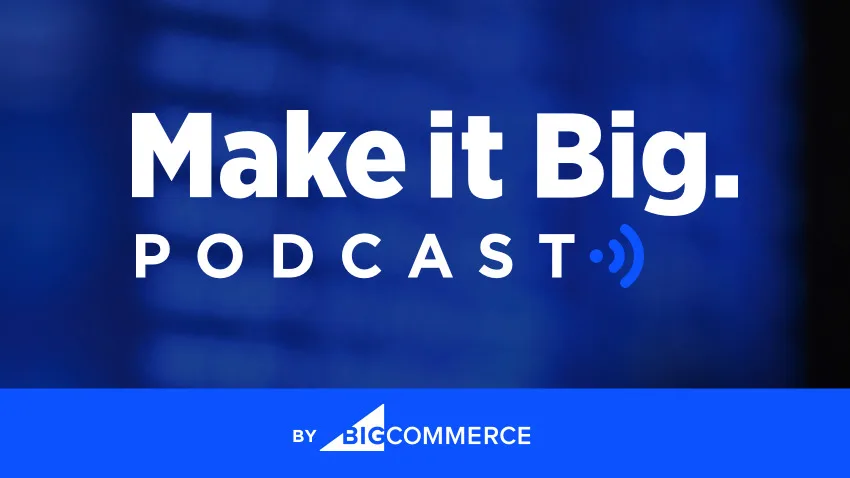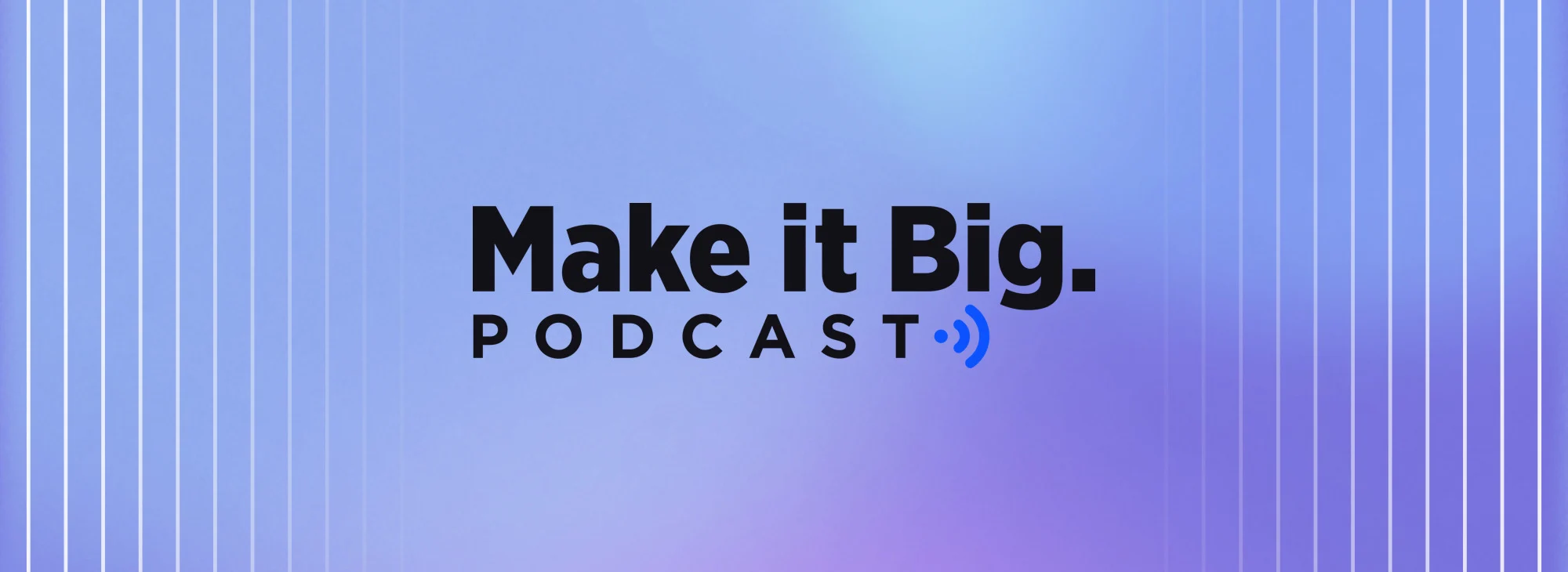
Ecommerce insights on the go
Tune in to the Make it Big Podcast — our thought leadership audio series for retailers, entrepreneurs and ecommerce professionals. You'll get expert insights, strategies and tactics to help grow your business.

Make it Big Podcast: Optimizing Checkout for a Frictionless User Experience

Welcome to The Make it Big Podcast, a bi-weekly audio series about all things ecommerce by BigCommerce.
In this episode, CEOs from BigCommerce and one-click checkout solution Fast discuss the latest trends in checkout optimization and the role it plays in the larger shopping experience. Brent Bellm and Domm Holland offer expert insights on user experience and digital innovation, along with actionable advice on what makes customers convert.
They’ll discuss how payments are transforming the ecommerce landscape, the importance of checkout in creating a frictionless user experience, plus digital innovation and the future of online checkout optimization.
All episodes of The Make it Big Podcast are now available on Spotify, Apple and Google.
The Make it Big Podcast: Episode 8
Brent Bellm: What makes Fast the next iteration of great checkout experience?
Domm Holland: _“The problem that Fast set out to solve is to make the fastest and easiest way for consumers to check out. Right? This seems like a no brainer. But when we think about what is the fastest and easiest way for a consumer to check out, the answer is obviously to be buying in one click. From the moment you want to buy something, click and buy. _
“But it’s one click from the moment they actually want to buy that item. For everything that we’ve just described, the typical experience to even use PayPal, Google Pay, Apple Pay, name your payment button and that wall of buttons we see. Typically, you’ve heard about a product from social media, or from an article or something like that. You click the link to go to the website. You look at a product page. You click add to cart, view cart, check out. Then you enter your email address because they want to know if you’re a user or not. If you’re not a user, then they’ll show you, give us your address, and then they typically show you payment at the end. They say, ‘How do you want to pay for this?’ Then they give you this wall of buttons.
“The reality as we’ve just seen is, you’ve had 10 steps just to get to that point. So, they can call it one click, one touch, whatever they’d like. The reality is, you’re at your 11th or 12th touch at that point.
“So, the difference at Fast is, we want to bring all of that forward. One of the biggest differentiators you see is that every retailer or merchant that uses Fast — and it’s a big and very fast growing network — puts Fast checkout on the product page. It’s a button that says Fast checkout. It’s typically above the add-to-cart button. So, you still have an add-to-cart option. It says Fast Checkout or add to cart. If you click Fast Checkout from the product page, in one click, you purchase a product. That is the fastest and easiest way to buy anything.”
BB: In [Amazon’s] case, a lot of people with Prime, they don’t pay for shipping. Each time you see something you want to buy, you just hit Buy Now — but you can buy four or five things, and it all gets aggregated into one order.
DH: “This is exactly right. Amazon has actually shown the world the winning model, as you have a Buy Now button and an Add to Cart button. If people still want to clear their cart or check totals, that’s perfectly fine. But if they just need to buy something — make it easy for them to buy it.
“Amazon powers more ecommerce than anyone else in the world. They’ve been very, very successful at this. But the reason is, as you exactly described, if you click four Buy Now buttons, even over different time periods, it’ll all turn up in the same box two days later. It’s not like you end up with four boxes.
“Amazon’s very good at batching things into one box. If you notice, Amazon doesn’t charge your card immediately. They’ll charge your card a little bit later on. They might batch the payments for those two purchases.”
BB: Because they don’t want to pay the fixed credit card fees multiple times.
DH: “Exactly. So, Fast does this for every single one of our merchants out of the box. So, we have batching built in. A customer can go to a product page, click Fast checkout, and we say, ‘Order complete.’
“Then they can keep browsing, or they can come back five minutes later and click Fast checkout again on a different product, and we’ll batch them into the same order in the merchant’s back end. Their average order value skyrockets. Their items per order stays high. In fact, it continues to increase. I think our average items per order across our entire network is 2.39, so it’s very high as an industry average, let alone from the fact that over half of our transactions come from the product page.
“Our shipping costs are low and payment costs are low. For consumers, when they do that, we batch, if the merchant does have a shipping fee, or a free shipping threshold, likely, the consumer now hits the free shipping threshold once they’ve bought the second or third item.
“So, it’s great for business, great for consumers. Our average conversion rate increase across our network is 60%. So, you can tell the impact it has on business by exposing checkout to everyone who looks at a product, not just people who get into this checkout flow.”
BB: Let’s talk about what’s different in the user experience.
DH: “A lot of companies are trying to build a better checkout form. Every business for themselves should be optimizing their own checkout form. But there’s a lot of networks out there, or payment buttons, or whatever else, that are trying to offer businesses a better checkout form. Fast eliminates the checkout form. There’s no point. You don’t need to have a checkout form.
“To explain the first time a user ever uses Fast checkout — they’ll land on a site, whether it’s a plumbing site or any other site that uses Fast checkout, and they’ll see a button that says Fast checkout. It pops up straightaway with a little form where you enter your email, your name, your phone number, your delivery address and your credit card number. That’s the first time you ever use Fast. You click process transaction.
“Then the order goes through and you can buy another product in one click in that session now. You can keep browsing the site and click Fast checkout again. The next time you click Fast checkout, whether it’s on that site 10 seconds later, or whether it’s on a completely different site you’ve never seen a month later, when you click it, it’ll just say order complete. This is the exact way that commerce should work. You’re trying to buy something and we tell you that you’ve bought it.
“So, that’s the Fast experience. We have removed every single ounce of friction in that process, which is why it feels so different — because we’re used to so much friction in this buying experience. So, we have flipped that on its head and removed all the friction.
“The difference, rather than make 100% of people confirm every step: We don’t move addresses every two minutes, so we shouldn’t have to keep asking people, ‘Yes, the same address they used two minutes ago is the one I want to use right now.’ Instead of making 100% of people confirm everything — instead we make 0% of people have to confirm everything.
“We’ll go straight to a confirmation screen, but we give you five minutes if you want to change anything. You could add a coupon code. You could change your address. You could change your card. You could change the quantity of what you’re buying, or you could just walk away and know that your products are going to be delivered a couple of days later.
“So, that’s the Fast experience. It really is the fast and the easiest way for people to buy.”
BB: What are the two or three statistics that you anchor your argument on what Fast does to improve?
DH: “Fast increases your conversion rate by an average of 60%. That’s across our entire network. It’s a staggering, staggering statistic.
“As we mentioned, over half of all the Fast orders come from the product page. So, I know that there’s a ton of people sitting there cringing, going, ‘Oh, all of our costs are going to go up, and our average order value’s going to go down.’
“So, now that we’ve got those two statistics out of the way, the last two are the most, and two very important, to go with. That is, our average items per order across the Fast network is 2.39. It is very high. In fact, it continues to increase. We see our average items per order continue to increase across our network.
“The average order value for Fast, across our entire network, is $220. Again, the averages for ecommerce are much lower than this. Average items per order is 1.8 on average, across the network.
“So again, the reason why merchants have typically flocked to Fast to date has been product page checkout with our batching technology. All of their metrics go up and to the right. It’s a no brainer.”
BB: I’m going to push you, Domm, and say, are you thinking about — because you can’t change the cost of interchange — are you thinking about other potential inexpensive ways of paying in America, like bank-based payments, and trying to get those into your option set?
DH: “Yeah. Short answer to your question is, you will see a number of more local payment methods added to Fast over the next 12 months in different markets. You’ve mentioned a lot of European markets, Asian markets that have a lot of local payment methods. South America has a number of different local payment methods that are very popular that we will use.
“A lot of that is less, for us, about reducing our cost base, and more about allowing people to pay in the way that they want to pay. Sometimes credit cards just aren’t used heavily in a lot of markets. So, you have to be using the alternative payment methods that they’re using in market.”
BB: Why would banks here go and release direct payments, free direct payments from bank accounts? Because they’re the parties who are actually profiting the most from the payments in the first place.
There is one and only one explanation for why banks, to this day, still have not enabled free payments and you’ve had to use things like PayPal, and Zelle, and Venmo to send payments from person to person — because our banks have not enabled electronic funds transfer. That is, especially in checkout and commerce, because they don’t have any financial incentive to do it.
It’s only going to happen either through political pressure — or disruption.
For full episodes, stream The Make it Big Podcast on Spotify, Apple and Google.

Krystin Gresham is a Content Marketing Manager at BigCommerce where she focuses on thought leadership content. Krystin holds a BBA in Marketing from Texas A&M University. With a background in both retail and tech, Krystin enjoys staying up on the latest retail and technology trends in the ecommerce industry. When she's not crafting content, Krystin enjoys traveling with her husband and volunteering with the Junior League of Austin.


